Fiskars Bundle
Can Fiskars Group Continue its 375-Year Legacy of Growth?
Fiskars Group, a titan in the consumer goods sector, is charting its course for continued expansion. From its origins in 1649 to its current global presence, the company's journey is a testament to its adaptability. Its strategic acquisitions, like Georg Jensen, have significantly bolstered its portfolio, setting the stage for future success.
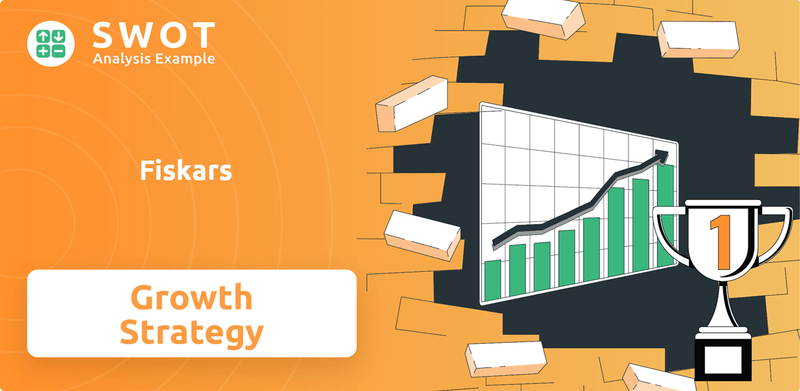
This Fiskars SWOT Analysis will explore the Fiskars growth strategy and delve into the Fiskars future prospects, analyzing the Fiskars company analysis to understand its strategic initiatives and Fiskars market share in the evolving market. We'll examine the Fiskars business model, Fiskars financial performance, and the impact of Fiskars acquisitions and mergers to provide a comprehensive overview of its long-term growth potential, considering factors like Fiskars product innovation strategy and Fiskars expansion into new markets.
How Is Fiskars Expanding Its Reach?
The company is actively pursuing several expansion initiatives to drive future growth, focusing on deepening its market presence and diversifying its offerings. A significant strategic move announced in the fourth quarter of 2024 is the plan to separate its two Business Areas, Fiskars and Vita, into operationally independent companies. This separation, effective April 1, 2025, aims to accelerate their distinct strategic growth opportunities and investment needs, enabling a more 'brands-first' approach and increasing flexibility and speed of execution.
The Fiskars growth strategy, launched in November 2021 and extending to 2025, emphasizes 'winning brands, winning channels, and winning countries.' This includes a strong focus on Direct-to-Consumer (DTC) sales, which saw a 9% increase in comparable sales in Q1 2025, with both its own retail network and e-commerce growing by 9% and 10% respectively. In 2024, DTC sales already accounted for 50% of Business Area Vita's net sales, supported by approximately 500 stores and 60 e-commerce sites globally.
Fiskars Group is also investing in category expansion. For example, 20% of Moomin Arabia's net sales in 2024 came from textiles, demonstrating efforts to 'surround the consumer' with a broader product offering. In 2024, Wedgwood introduced fine bone china pet bowls and Georg Jensen launched new home appliances, further illustrating these expansion efforts. Geographically, the U.S. market remains a key focus, contributing approximately 30% of Fiskars Group's net sales and about 50% of Business Area Fiskars' net sales. The company is enhancing its innovation pipeline and accelerating DTC in the U.S. Additionally, Fiskars Group is investing EUR 15 million in the Rogaska glass factory in Slovenia between 2024 and 2026, where Waterford crystal products are manufactured, to strengthen its premium and luxury product focus. This investment also aligns with expanding facilities in Slovenia. For a deeper dive into the consumer base, check out the Target Market of Fiskars.
The company is heavily investing in DTC channels. In Q1 2025, comparable sales in DTC saw a 9% increase, with both its retail network and e-commerce growing significantly. This strategic focus is supported by a global network of approximately 500 stores and 60 e-commerce sites.
Fiskars is expanding its product categories to offer a wider range of products. The introduction of textiles by Moomin Arabia, contributing to 20% of its 2024 net sales, exemplifies this strategy. Further, the launch of pet bowls by Wedgwood and home appliances by Georg Jensen showcases the company's efforts to broaden its offerings.
The U.S. market remains a crucial focus for the company. The U.S. market contributes approximately 30% of Fiskars Group's net sales and about 50% of Business Area Fiskars' net sales. Investments are also being made in the Rogaska glass factory in Slovenia to strengthen its premium and luxury product focus.
The separation of Fiskars and Vita into independent companies, effective April 1, 2025, is designed to accelerate growth. This strategic move aims to allow each business area to pursue its own growth opportunities and investment needs. This 'brands-first' approach is intended to increase flexibility and speed of execution.
Fiskars Group is implementing several key strategies to drive growth and enhance its market position. These strategies include a strong emphasis on DTC sales, category expansion, and geographic focus, particularly in the U.S. market. The separation of business areas will also play a crucial role.
- Investing in Direct-to-Consumer (DTC) channels to increase sales and market reach.
- Expanding product categories to offer a broader range of products and enhance consumer engagement.
- Focusing on key geographic markets, particularly the U.S., to drive revenue growth.
- Separating business areas to enable more focused strategic growth and investment.
Fiskars SWOT Analysis
- Complete SWOT Breakdown
- Fully Customizable
- Editable in Excel & Word
- Professional Formatting
- Investor-Ready Format
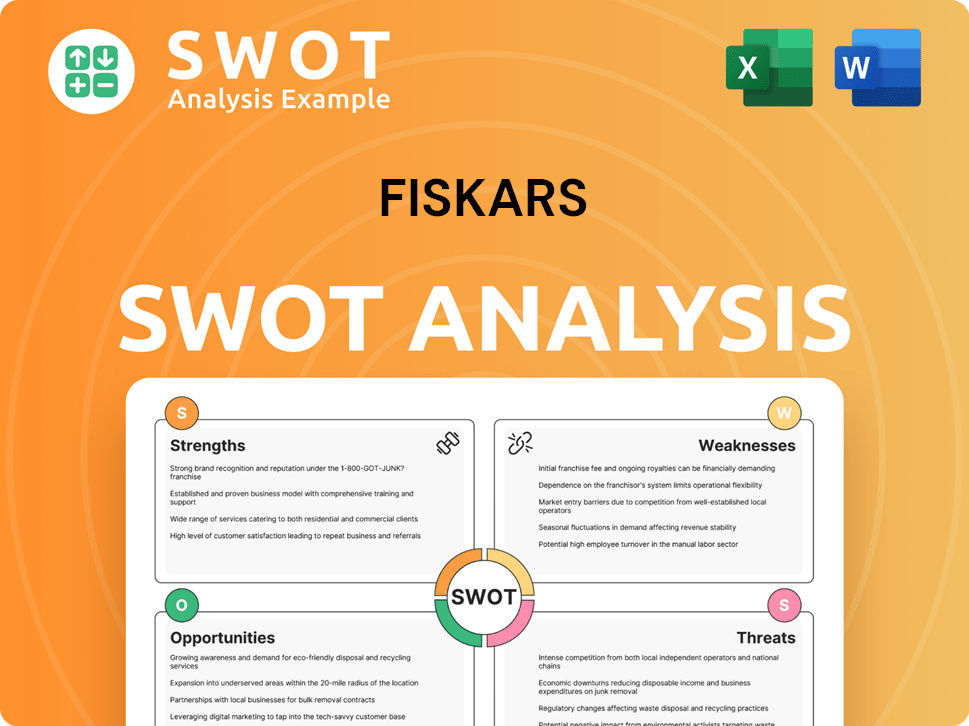
How Does Fiskars Invest in Innovation?
The innovation and technology strategy of Fiskars Group is a core driver for its sustained growth. The company focuses on pioneering design and digital transformation to maintain its competitive edge. This approach is crucial for understanding the Owners & Shareholders of Fiskars and its future prospects.
Fiskars Group consistently wins awards for its innovative designs. The company's commitment to sustainability is also a key part of its strategy. These efforts are designed to enhance customer experience and drive business growth.
Digital transformation and sustainability are key pillars of the company's strategy. These elements support the company's long-term growth potential and market position.
The Fiskars brand has been recognized for its design excellence. It has won awards in the Red Dot Design Awards for 16 consecutive years. The company has accumulated a total of 64 awards since 1955.
Fiskars Group is focusing on digital transformation to strengthen its Direct-to-Consumer (DTC) business. The company is transitioning to SaaS-based services to improve efficiency and scale its DTC operations more effectively.
Sustainability is integrated into Fiskars Group's innovation and business development processes. The company aims for the majority of its net sales to come from circular products and services by 2030.
The transition to SaaS-based services is aimed at enhancing digital capabilities. This shift allows access to the latest technical features, supporting the company's digital transformation strategy.
Fiskars Group achieved a Platinum level sustainability rating from EcoVadis in 2024. The company also received an A- rating for its climate actions from CDP in 2024, demonstrating its commitment to environmental responsibility.
The company has set science-based targets to reduce greenhouse gas emissions. The goal is to reduce emissions from its own operations (Scope 1 and 2) by 60% by 2030. The company also aims to cut emissions from transportation and distribution (Scope 3) by 30% by 2030.
Fiskars Group's strategic initiatives include a strong focus on innovation, digital transformation, and sustainability. These initiatives are designed to drive revenue growth and enhance the company's competitive landscape.
- Product Innovation: Continuous development of new products and designs, as evidenced by the Red Dot Design Awards.
- Digital Transformation: Transitioning to SaaS-based services to improve DTC operations and enhance digital capabilities. An impairment of EUR 27 million of internally generated intangible assets related to DTC software was made in Q1 2025.
- Sustainability: Aiming for the majority of net sales from circular products and services by 2030. This figure stood at 26% at the end of 2024 and expanded from 15% to 27% in Q1 2025.
- Supply Chain Optimization: Over 60% of Fiskars Group's suppliers by spend had set science-based emission reduction targets by 2024.
Fiskars PESTLE Analysis
- Covers All 6 PESTLE Categories
- No Research Needed – Save Hours of Work
- Built by Experts, Trusted by Consultants
- Instant Download, Ready to Use
- 100% Editable, Fully Customizable
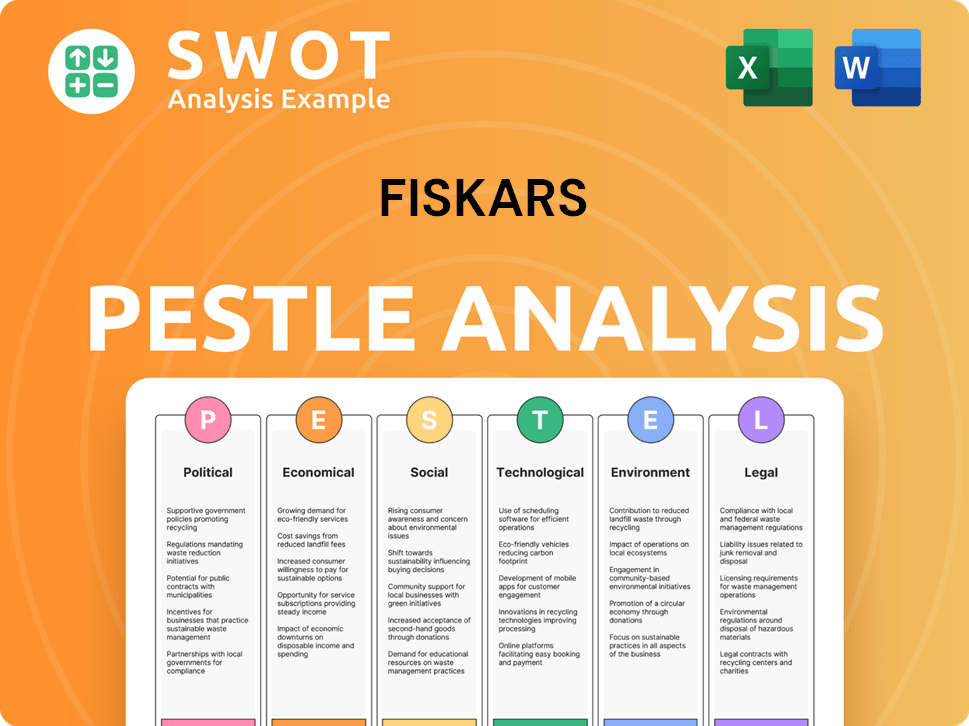
What Is Fiskars’s Growth Forecast?
The financial outlook for the company indicates a focus on growth and improved profitability. The company's performance in Q1 2025 showed positive signs, with increasing net sales and a rise in comparable EBIT. These results are a step forward in the company's overall Fiskars growth strategy.
For 2025, the company anticipates an improvement in comparable EBIT from the 2024 level. The company's strategic initiatives are geared towards driving revenue growth and enhancing financial performance. The company's Fiskars future prospects look promising, with a focus on sustainable growth and market expansion.
The company's financial performance in 2024 showed resilience despite challenges. The company's financial forecasts and projections suggest a path toward achieving its long-term growth potential. The company's Fiskars company analysis reveals a commitment to operational efficiency and strategic investments.
In Q1 2025, the company reported a 1.7% increase in comparable consolidated net sales, reaching EUR 291.9 million. Reported net sales increased by 3.2% in Q1 2025. Comparable EBIT for Q1 2025 increased to EUR 26.8 million, or 9.2% of net sales, up from EUR 25.1 million (8.9%) in Q1 2024.
The company's global net sales for 2024 were EUR 1.2 billion. Comparable net sales decreased by 5% in 2024. The full-year comparable EBIT for 2024 was EUR 111.4 million, slightly up from EUR 110.3 million in 2023. The gross margin for 2024 reached 48.8%, indicating progress toward its 2025 goal.
Cash flow from operating activities before financial items and taxes improved to EUR -2.1 million in Q1 2025, compared to EUR -5.5 million in Q1 2024. Capital expenditure totaled EUR 8.7 million in Q1 2025, primarily allocated to IT and supply chain projects. In 2024, capital expenditure was EUR 52.5 million.
The company aims for a target comparable EBIT margin of around 15%. Current forecasts suggest a margin of around 10% for 2025. The company is targeting an improvement to around 12% by 2026-2028, with the Vita segment playing a key role in this improvement.
The company's strategic focus includes cost management and revenue growth to improve profitability. The company's business model is designed to adapt to changing market conditions. The company's commitment to sustainability efforts is also a key part of its long-term strategy. For more insights into the company's values and mission, refer to Mission, Vision & Core Values of Fiskars.
The company focuses on increasing net sales and managing costs to drive revenue growth. The first organic growth quarter since Q2 2022, with a 1.7% increase in comparable consolidated net sales, indicates successful revenue strategies.
Continued cost management has been a key factor in improving profitability. The company's focus on efficient operations contributes to improved EBIT margins. This is crucial for the company's Fiskars financial performance.
The company targets an EBIT margin of around 15%, with current forecasts around 10% for 2025. The company aims to improve its EBIT margin to approximately 12% by 2026-2028, which is critical for long-term growth.
Capital expenditure is primarily focused on IT and supply chain projects. In Q1 2025, capital expenditure totaled EUR 8.7 million. The company's investments support its strategic initiatives.
The gross margin for 2024 reached 48.8%. The company is on track to achieve its ambition of over 49% in 2025. This improvement in gross margin supports the company's profitability goals.
The Vita segment is crucial for achieving the targeted EBIT margin improvement by 2026-2028. This segment's performance will significantly impact the company's overall financial outlook. The success of this segment is vital for the company's Fiskars market share growth.
Fiskars Business Model Canvas
- Complete 9-Block Business Model Canvas
- Effortlessly Communicate Your Business Strategy
- Investor-Ready BMC Format
- 100% Editable and Customizable
- Clear and Structured Layout
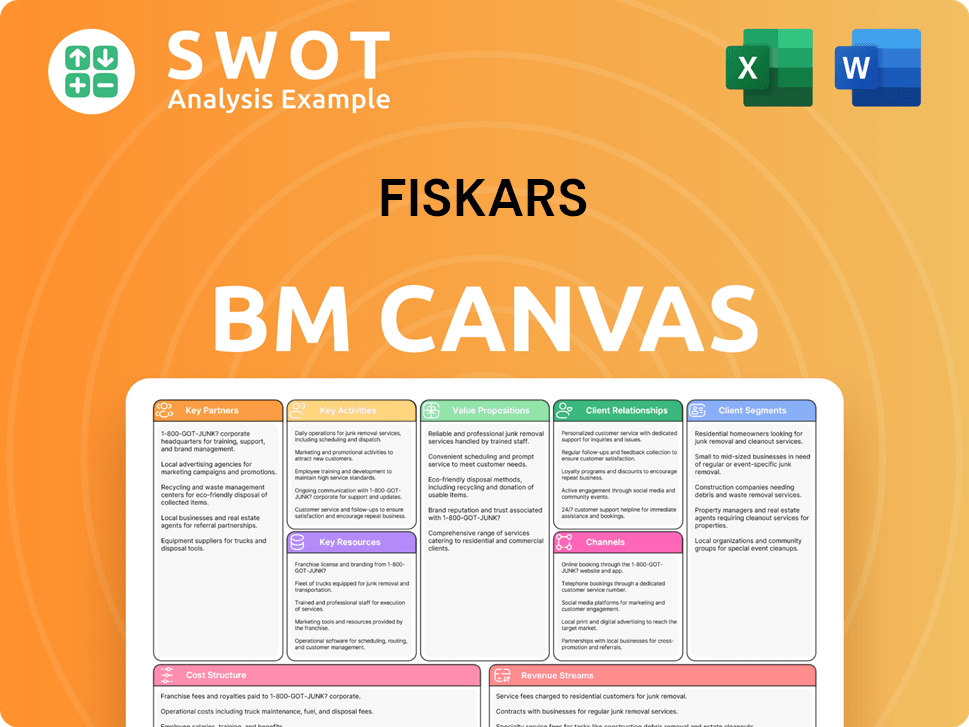
What Risks Could Slow Fiskars’s Growth?
Understanding the potential risks and obstacles is crucial when analyzing the Fiskars growth strategy. The company faces a complex set of challenges that could impact its Fiskars future prospects. These challenges range from economic uncertainties to operational hurdles.
One significant factor is the impact of U.S. tariffs announced in early April 2025. These tariffs are expected to increase sourcing costs, which could affect the company's financial performance. Market competition, low consumer confidence, and retailer inventory management also continue to pose challenges that could influence Fiskars market share.
The ongoing separation of business areas also introduces risks. These risks include potential delays, increased costs, and challenges in implementing IT system changes. These factors could impact the company's overall strategic goals. For a deeper understanding of the company's origins, consider reading a Brief History of Fiskars.
The U.S. market accounts for approximately 30% of the company's net sales. The tariffs are expected to increase sourcing costs, particularly for products imported from China. This situation could indirectly affect consumer confidence in the U.S. and globally, potentially impacting demand and Fiskars financial performance.
Market competition and low consumer confidence continue to affect demand and net sales. In 2024, comparable net sales decreased by 5% due to low consumer confidence. There is a risk of weakening consumer demand in the U.S. in the latter half of 2025 if tariffs lead to higher consumer prices, which impacts Fiskars business model.
Fluctuations in raw material prices, energy costs, and shipping can negatively impact profitability. Dependency on single sources of supply could lead to business interruptions. The company is actively working to diversify its sourcing away from China, potentially to other subcontractors or its own factories in Europe, as part of its Fiskars supply chain optimization.
Technological disruption and the increasing reliance on centralized IT systems present cybersecurity risks. Breaches or malfunctions could disrupt operations and harm the company's reputation and financials. Risks related to major IT projects, such as conflicting data, budget overruns, or delays, can also negatively affect business. This underscores the importance of a strong Fiskars digital transformation strategy.
The ongoing separation of Business Areas Fiskars and Vita carries risks. These risks include potential delays in project timelines, increased costs, and challenges in implementing IT system changes. Concerns among personnel could also impact employee retention, affecting the company's ability to execute its Fiskars strategic initiatives 2024.
The company mitigates risks through diversification and proactive measures. Maintaining a diversified commercial footprint across geographies and product portfolios reduces dependence on any single market or product. Management also continuously adapts business procedures and organizational structure to enhance agility and responsiveness to market changes, highlighting its Fiskars long-term growth potential.
Economic trends significantly impact the company's performance. Low consumer confidence, influenced by factors like inflation and economic uncertainty, directly affects demand. Changes in currency exchange rates and interest rates also play a role. Understanding these trends is crucial for effective Fiskars competitive landscape analysis.
The company faces challenges related to sourcing and operational efficiency. Rising raw material costs and logistical issues can squeeze profit margins. The ability to optimize supply chains and manage production costs effectively is essential. These factors are key to Fiskars revenue growth drivers.
Brand positioning and marketing strategies are critical in a competitive market. Maintaining brand relevance and consumer loyalty are essential for sustained growth. Understanding and adapting to changing consumer preferences is key. This affects Fiskars brand positioning and marketing.
Investor relations and the overall market outlook influence the company's valuation. Maintaining transparent communication with investors and providing clear financial forecasts are crucial. The company's ability to manage expectations and deliver on its strategic goals affects Fiskars investor relations and outlook.
Fiskars Porter's Five Forces Analysis
- Covers All 5 Competitive Forces in Detail
- Structured for Consultants, Students, and Founders
- 100% Editable in Microsoft Word & Excel
- Instant Digital Download – Use Immediately
- Compatible with Mac & PC – Fully Unlocked
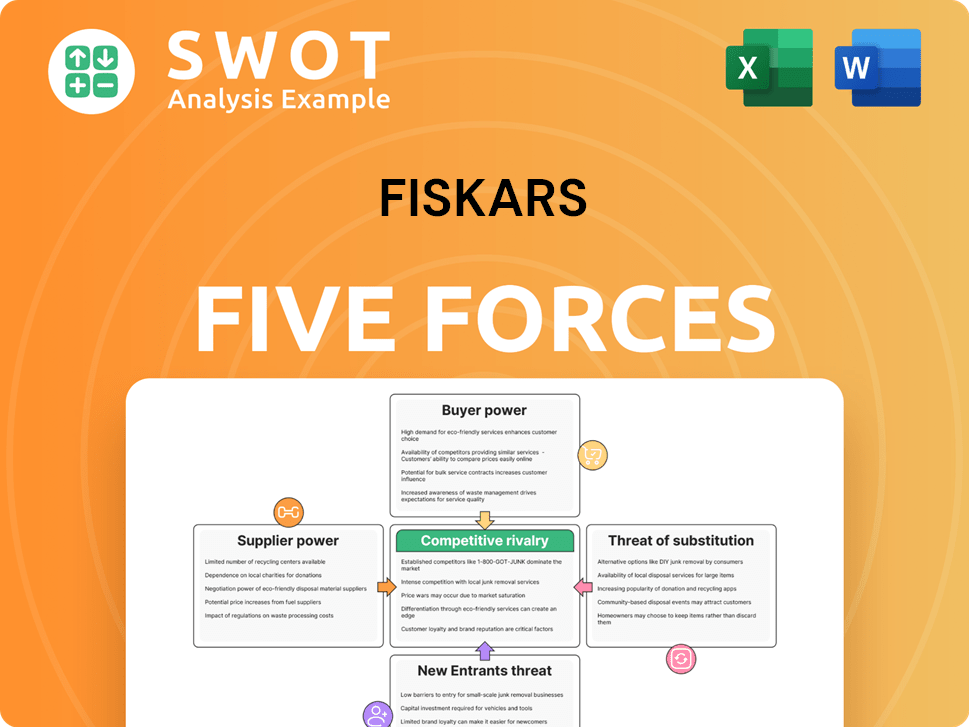
Related Blogs
- What are Mission Vision & Core Values of Fiskars Company?
- What is Competitive Landscape of Fiskars Company?
- How Does Fiskars Company Work?
- What is Sales and Marketing Strategy of Fiskars Company?
- What is Brief History of Fiskars Company?
- Who Owns Fiskars Company?
- What is Customer Demographics and Target Market of Fiskars Company?
Disclaimer
All information, articles, and product details provided on this website are for general informational and educational purposes only. We do not claim any ownership over, nor do we intend to infringe upon, any trademarks, copyrights, logos, brand names, or other intellectual property mentioned or depicted on this site. Such intellectual property remains the property of its respective owners, and any references here are made solely for identification or informational purposes, without implying any affiliation, endorsement, or partnership.
We make no representations or warranties, express or implied, regarding the accuracy, completeness, or suitability of any content or products presented. Nothing on this website should be construed as legal, tax, investment, financial, medical, or other professional advice. In addition, no part of this site—including articles or product references—constitutes a solicitation, recommendation, endorsement, advertisement, or offer to buy or sell any securities, franchises, or other financial instruments, particularly in jurisdictions where such activity would be unlawful.
All content is of a general nature and may not address the specific circumstances of any individual or entity. It is not a substitute for professional advice or services. Any actions you take based on the information provided here are strictly at your own risk. You accept full responsibility for any decisions or outcomes arising from your use of this website and agree to release us from any liability in connection with your use of, or reliance upon, the content or products found herein.